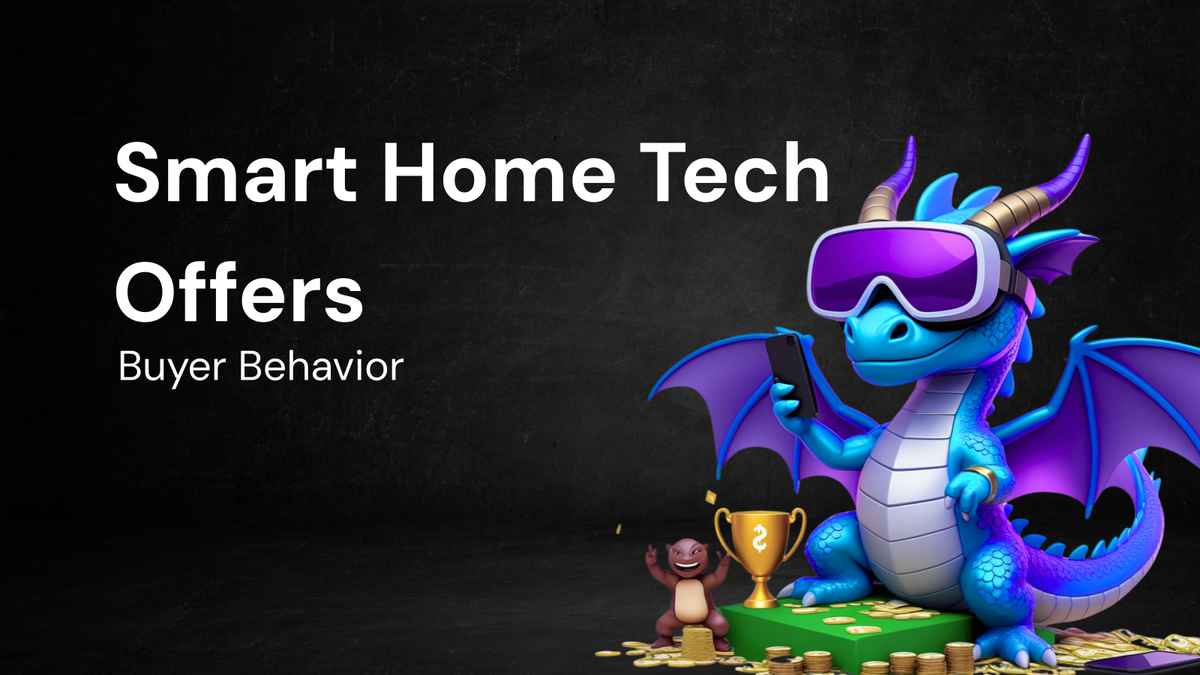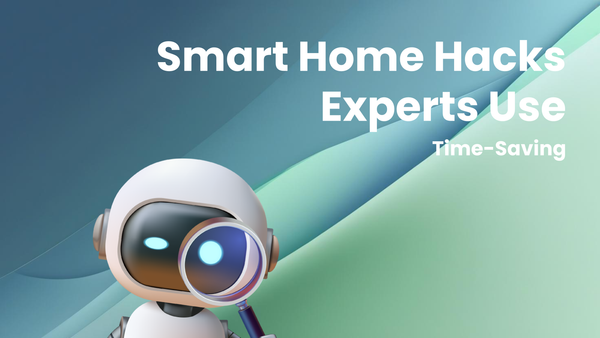Hidden Offers for Smart Home Tech: A Look at Buyer Behavior

Hidden Offers for Smart Home Tech: A Look at Buyer Behavior
The smart home revolution is in full swing. From voice-controlled assistants to intelligent thermostats, we're increasingly integrating technology into our living spaces to enhance convenience, security, and energy efficiency. But navigating the smart home tech market can feel like traversing a dense jungle. While flashy discounts and advertised bundles grab our attention, a world of "hidden offers" – subtle promotions, personalized deals, and strategic marketing tactics – often lies beneath the surface, influencing our buying behavior in ways we might not even realize.
This blog delves into the fascinating realm of hidden offers in the smart home tech market. We'll explore the various types of these offers, analyze the psychological principles that make them effective, and examine how buyer behavior is subtly shaped by these often-unseen strategies. By understanding the landscape of hidden offers, consumers can make more informed and strategic purchasing decisions in the ever-evolving smart home market.
I. Defining "Hidden Offers" in the Smart Home Tech Market
The term "hidden offer" encompasses a broad range of promotional strategies that aren't always immediately apparent to the average consumer. They go beyond the standard advertised discounts and instead rely on subtlety, personalization, and strategic timing to incentivize purchases. Here's a breakdown of common types:
- Bundled Deals with Hidden Value: These are more than just straightforward discounts on multiple products. They often include less-obvious additions like free installation, extended warranties, or access to premium features. The true value of the bundle is not always immediately apparent, requiring consumers to carefully compare the components individually and as a whole.
- Loyalty Programs and Exclusive Access: Many smart home tech manufacturers and retailers offer loyalty programs that reward repeat customers with exclusive discounts, early access to new products, and personalized recommendations. These benefits are "hidden" in the sense that they are not readily available to the general public and require proactive enrollment and engagement.
- Trade-In Programs with Upselling Opportunities: Trade-in programs offer a discount on a new product in exchange for an older one. While seemingly straightforward, these programs often subtly encourage consumers to upgrade to a more expensive or feature-rich model, presenting an "upselling opportunity" that may not have been initially considered.
- Financing Options and Payment Plans: Offering financing options can make smart home tech more accessible, but it also allows companies to subtly influence purchasing decisions by framing the cost in smaller, more manageable installments. The long-term cost, including interest, might be less prominent, potentially leading to overspending.
- Personalized Recommendations and Targeted Advertising: Data collected from user behavior, purchase history, and smart home usage is used to generate personalized product recommendations and targeted advertising. These "hidden" nudges are designed to appeal to individual needs and preferences, making the offer more compelling and increasing the likelihood of a purchase.
- Subscription-Based Services with Free Trials: Many smart home devices rely on subscription-based services for advanced features like cloud storage, professional monitoring, or AI-powered automation. Free trials offer a taste of these premium features, subtly encouraging users to subscribe even after the trial period ends.
- Limited-Time Promotions and Flash Sales: These create a sense of urgency and scarcity, prompting consumers to make quick decisions without thoroughly researching alternatives. The perceived time pressure can lead to impulse purchases and overlooking potential hidden costs or limitations.
- Referral Programs and Affiliate Marketing: Encouraging existing customers to refer new buyers through referral programs or partnering with affiliate marketers generates subtle promotions that are often perceived as more trustworthy than direct advertising.
- "Free" Gifts with Purchase: Offering a "free" smart accessory with the purchase of a main device can create a perception of added value, even if the accessory is of limited use or readily available at a low price elsewhere. This plays on the psychology of receiving something for "free."
II. Psychological Principles Driving the Effectiveness of Hidden Offers
The effectiveness of these hidden offers hinges on several key psychological principles that influence our decision-making processes:
- Anchoring Bias: The initial price presented (even if inflated) serves as an "anchor" that influences our perception of subsequent discounts or offers. For example, if a smart thermostat is initially priced at $300 and then discounted to $200, we perceive it as a great deal, even if the actual market value is closer to $180. Bundled deals also utilize anchoring by showcasing the combined regular price of all items to make the bundle price seem more appealing.
- Loss Aversion: People are more motivated to avoid losses than to acquire equivalent gains. Limited-time promotions and flash sales capitalize on this principle by creating a fear of missing out (FOMO). The potential "loss" of the discount or the product itself motivates immediate action.
- The Endowment Effect: We tend to overvalue things we already own or possess, even if we acquired them recently. Trade-in programs leverage this by emphasizing the value of the old device, making the upgrade seem more appealing and justifying the purchase of a new product.
- Reciprocity: When someone does something nice for us, we feel obligated to reciprocate. Offering a "free" gift with purchase triggers this sense of reciprocity, making us more likely to complete the purchase even if we didn't initially plan to.
- Cognitive Ease (Fluency Heuristic): We tend to prefer information that is easy to process and understand. Simplified payment plans and financing options make the overall cost seem less daunting, reducing cognitive friction and increasing the likelihood of purchase.
- Authority Bias: We tend to trust and obey figures of authority, even if they are perceived. Testimonials from "experts" or endorsements from trusted brands can significantly influence our purchasing decisions, even if the underlying offer is not objectively superior.
- Social Proof: We often look to others for cues on how to behave or what to buy. Personalized recommendations based on similar users' purchases leverage this principle. Seeing that others with similar needs and preferences have purchased a particular product increases our confidence in the decision.
- Framing Effect: The way information is presented can significantly influence our perception of its value. For example, emphasizing the monthly cost of a financing plan rather than the total cost makes the purchase seem more affordable. Highlighting the energy savings of a smart thermostat can make the upfront cost seem more justifiable.
III. How Buyer Behavior is Shaped by Hidden Offers
The psychological principles underpinning hidden offers directly impact buyer behavior in several ways:
- Increased Impulse Purchases: The urgency created by limited-time promotions and the allure of "free" gifts can lead to impulsive purchases, especially among consumers who are already interested in smart home tech.
- Brand Loyalty and Lock-In: Loyalty programs and subscription-based services foster brand loyalty by rewarding repeat customers and creating a dependence on specific ecosystems. This can make it difficult and expensive to switch to alternative brands or platforms in the future ("vendor lock-in").
- Overspending and Unnecessary Upgrades: Trade-in programs and upselling opportunities can encourage consumers to spend more than they initially intended or to purchase features they don't truly need. The perceived value of the upgrade often outweighs the actual utility.
- Data Privacy Concerns: The personalization of offers and targeted advertising relies on the collection and analysis of user data. While this can lead to more relevant recommendations, it also raises concerns about data privacy and security. Consumers may not be fully aware of how their data is being used and the potential implications.
- Increased Complexity in Decision-Making: The abundance of hidden offers and complex bundling options can make it difficult for consumers to compare different products and services effectively. This "choice overload" can lead to frustration and ultimately result in suboptimal purchasing decisions.
- Shift from Needs-Based to Wants-Based Purchasing: The constant barrage of personalized recommendations and targeted advertising can subtly shift consumers from purchasing based on their actual needs to purchasing based on perceived wants or desires. The emphasis on new features and innovative technologies can create a sense of obsolescence, even if existing devices are perfectly functional.
- Heightened Price Sensitivity: The constant exposure to discounts and promotions can make consumers more price-sensitive and less willing to pay full price for smart home tech. This can create a race to the bottom for manufacturers and retailers, potentially compromising product quality or customer service.
IV. Navigating the Landscape of Hidden Offers: A Consumer's Guide
Understanding the strategies behind hidden offers empowers consumers to make more informed and strategic purchasing decisions. Here are some tips for navigating the smart home tech market:
- Do Your Research: Before making any purchase, thoroughly research different products, brands, and retailers. Compare prices, features, and customer reviews to get a clear understanding of the market landscape.
- Be Aware of the Anchoring Bias: Don't be swayed by inflated initial prices. Focus on the actual market value of the product and compare it to similar alternatives.
- Resist the Urge to Impulse Buy: Take your time to consider your needs and preferences before making a purchase, especially during limited-time promotions.
- Read the Fine Print: Carefully review the terms and conditions of any bundled deals, financing options, or subscription-based services. Pay attention to hidden fees, interest rates, and cancellation policies.
- Question Personalized Recommendations: Be aware that personalized recommendations are based on algorithms that may not always accurately reflect your needs. Consider whether the recommended product truly aligns with your priorities.
- Prioritize Security and Privacy: Choose smart home devices and platforms that prioritize security and data privacy. Review the privacy policies of the manufacturers and understand how your data will be used.
- Consider Long-Term Costs: Factor in the long-term costs of ownership, including subscription fees, energy consumption, and potential repair costs.
- Don't Be Afraid to Negotiate: Contact retailers directly to inquire about potential discounts or promotions. You may be able to negotiate a better deal than what is publicly advertised.
- Seek Independent Reviews: Consult independent product reviews and comparisons from reputable sources to get unbiased opinions and assess the true value of different products.
- Focus on Your Needs: Ultimately, the best smart home tech is the technology that best meets your individual needs and preferences. Don't be swayed by flashy features or aggressive marketing tactics.
V. The Future of Hidden Offers in the Smart Home Market
The smart home tech market is constantly evolving, and we can expect to see even more sophisticated hidden offers in the future. Here are some potential trends to watch for:
- Increased Personalization: AI and machine learning will enable even more granular personalization of offers based on individual user behavior and context.
- Predictive Pricing: Algorithms will predict consumers' willingness to pay and adjust prices accordingly, maximizing profits while still creating a perception of value.
- Gamification of Purchasing: Smart home ecosystems may incorporate gamified elements, such as reward points and challenges, to further incentivize engagement and purchases.
- Integration with other Services: Smart home devices may be bundled with other services, such as insurance or energy plans, creating even more complex and integrated offers.
- Emphasis on Sustainability: Marketing efforts may increasingly focus on the sustainability benefits of smart home tech, appealing to environmentally conscious consumers.
Conclusion
The world of smart home tech is replete with hidden offers that subtly influence our buying behavior. By understanding the psychological principles behind these strategies and taking a proactive approach to research and decision-making, consumers can navigate the market more effectively and avoid falling prey to impulse purchases or unnecessary upgrades. As the smart home market continues to evolve, it's crucial to remain vigilant and informed, ensuring that our purchasing decisions are driven by genuine needs and preferences, rather than by cleverly disguised marketing tactics. The key is to be a smart consumer in the smart home.




